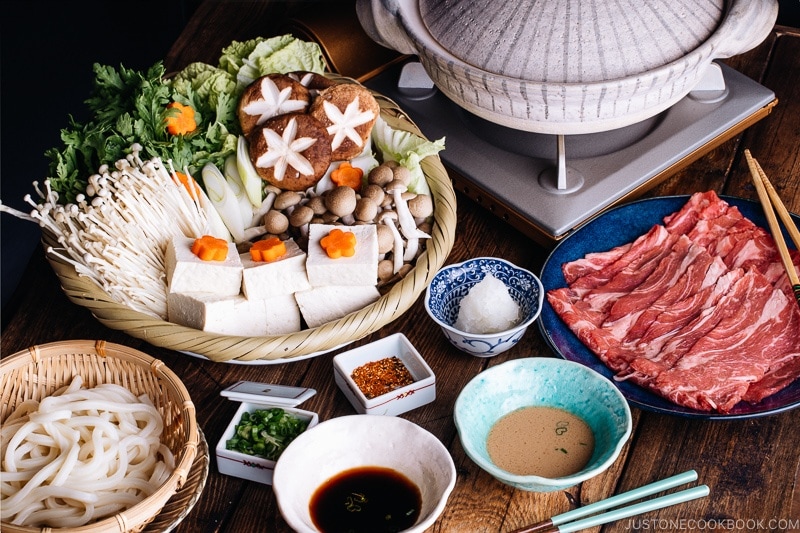
Shabu Shabu is a popular Japanese-style hot pot where the meat and assorted vegetables are cooked in a flavorful broth called kombu dashi. Everyone at the table takes part in the cooking and enjoys the ingredients with different dipping sauces. It’s intimate yet casual, and a whole lot of fun!
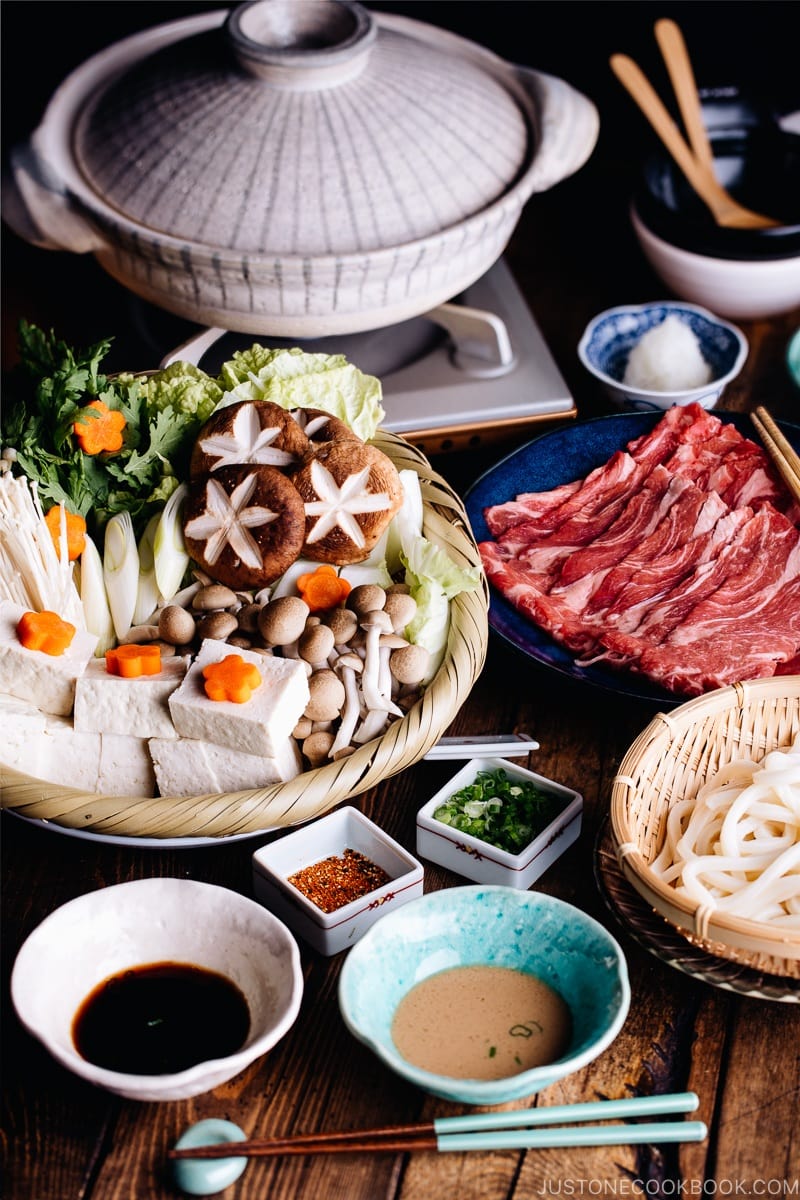
It’s the holiday season and it’s the time for friends and family to get together. What’s the best Japanese meal for this occasion? It’s Shabu Shabu (しゃぶしゃぶ)!
What is Shabu Shabu?
Shabu Shabu is one of Japan’s most popular hot pot dishes along with Sukiyaki. The name “shabu shabu” is Japanese onomatopoeic. It came from the sound when you stir the vegetables and meat with your chopsticks and ‘swish swish’ in the hot pot. It’s a fun meal since everyone sits around the hot pot at the table, cooks together, and eats while you chat, like fondue! A communal dining experience that inspires good appetites and brings people closer together.
Watch How to Make Shabu Shabu
Shabu Shabu is a popular Japanese-style hot pot where the meat and assorted vegetables are cooked in a flavorful broth called kombu dashi.
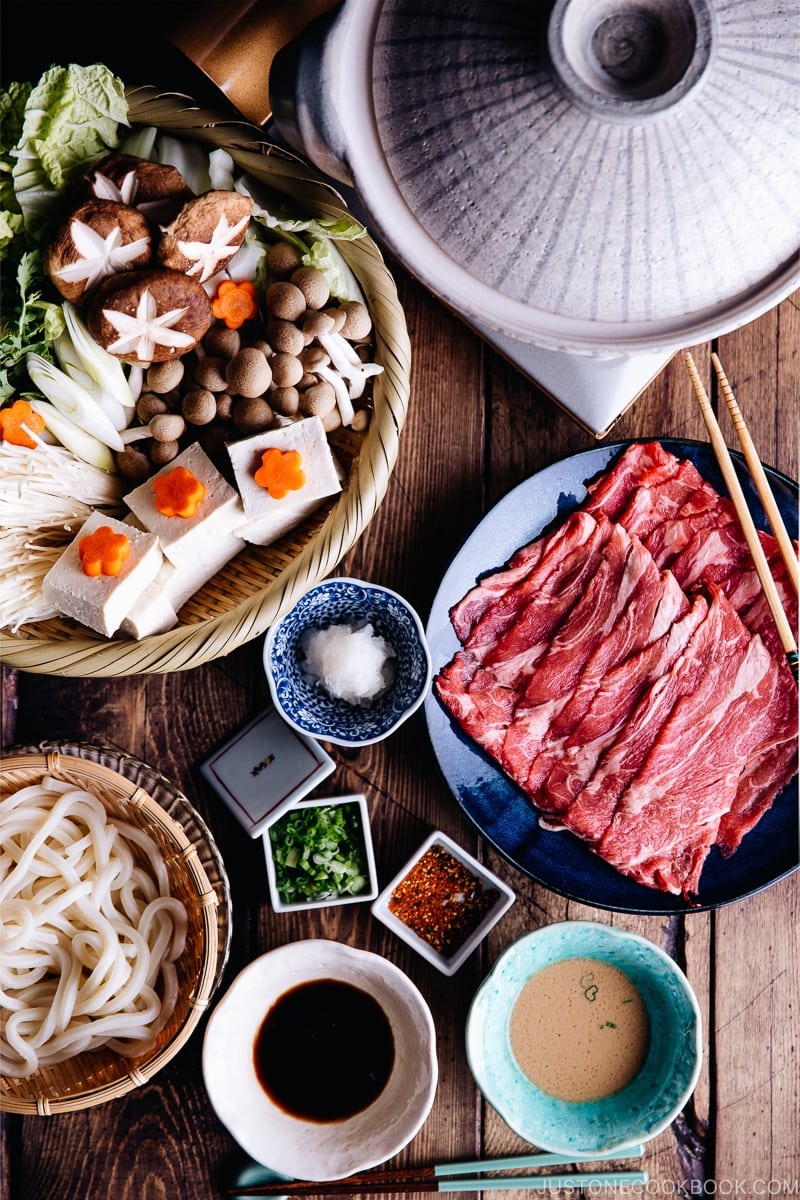
How to Prepare and Eat Shabu Shabu
The earthenware pot called donabe (土鍋) is set up on a portable gas stove in the center of the table. Inside is a simple yet umami-packed Japanese stock called Kombu Dashi. The uncooked ingredients are served on two large plates, one for thinly sliced well-marbled beef (or it can be pork), and the other one for vegetables and tofu.
Besides the platters of ingredients, each person is provided with dipping sauces. Typically, there are two types: sesame sauce and ponzu sauce.
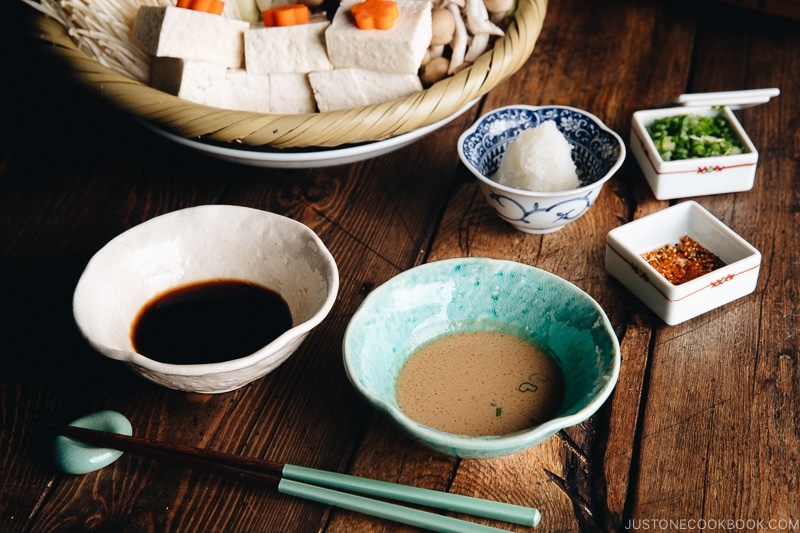
Once everyone is seated, you would start cooking with tough vegetables and tofu, following by softer vegetables. Paper-thin slices of meat take only a few seconds to cook. When you want to eat meat, you would pick up a slice with the communal chopsticks, and stir in the broth for a few seconds, and transfer to your own bowl of a dipping sauce.
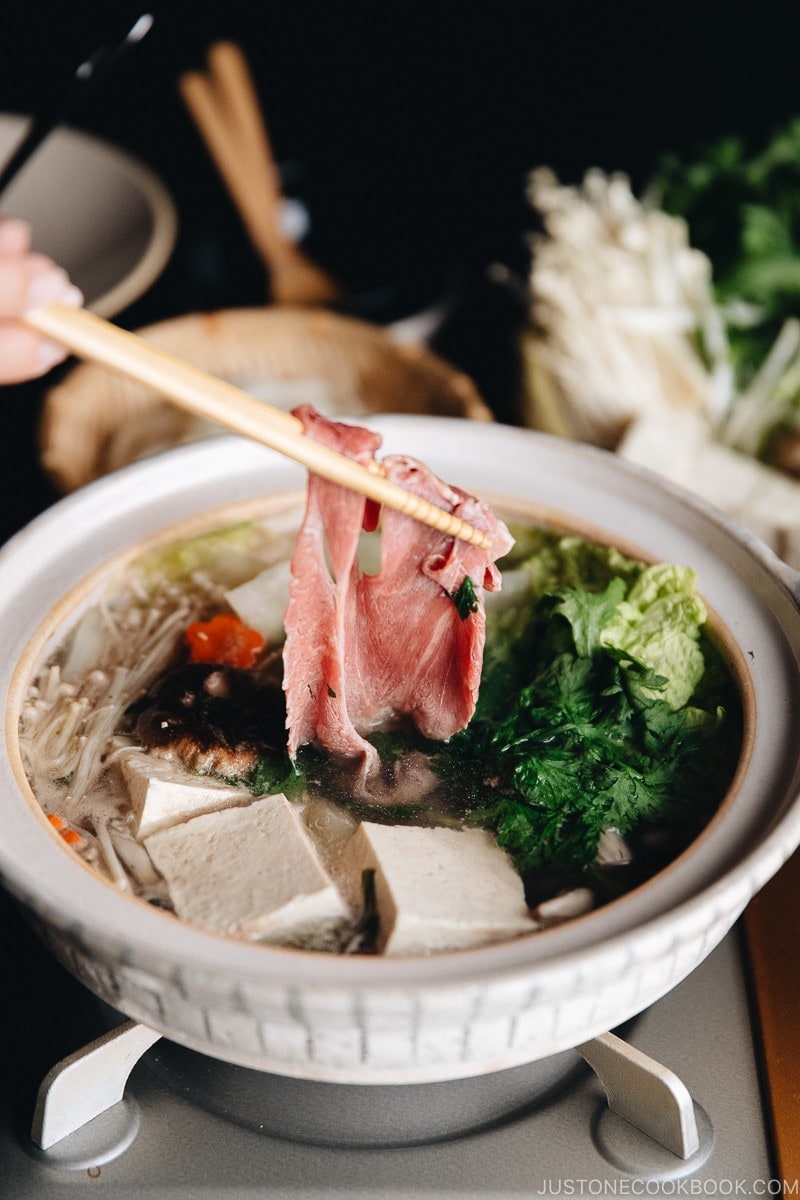
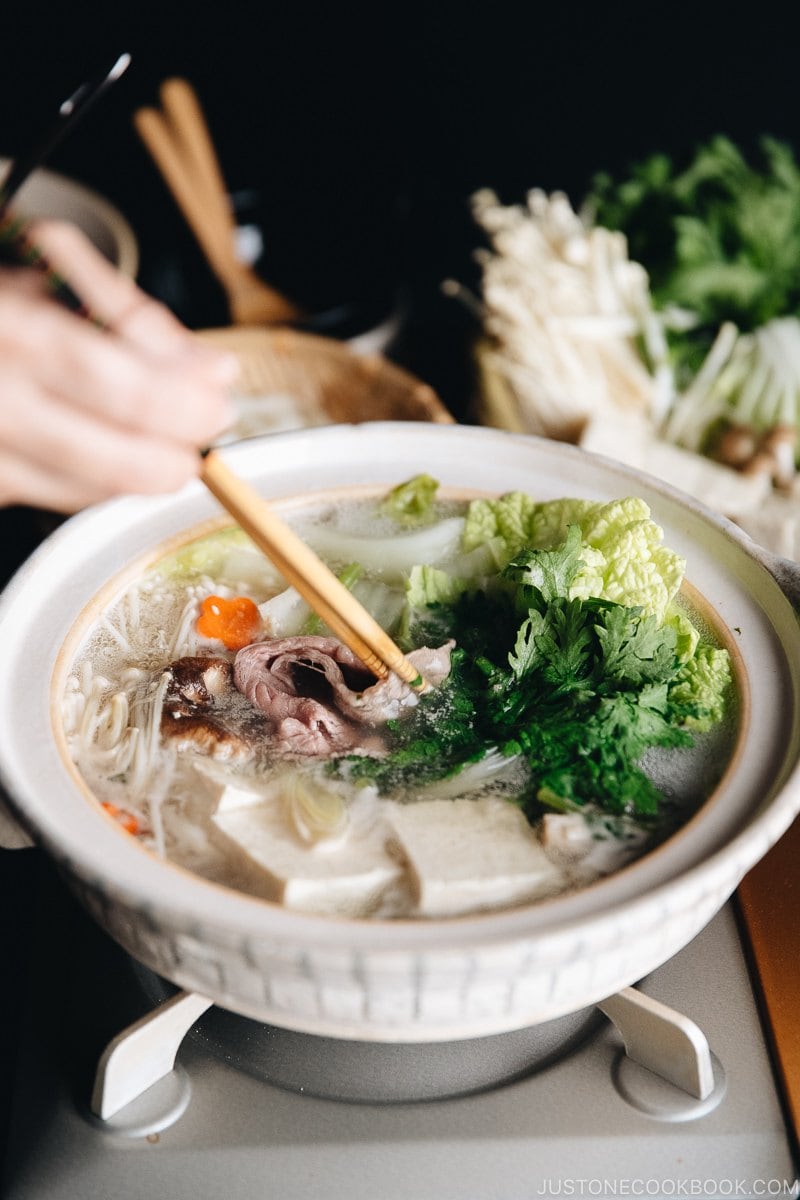
You can dip cooked vegetables, tofu, and meat in either of your sesame or ponzu sauce. I personally love meat in sesame sauce and vegetables and tofu in ponzu sauce.
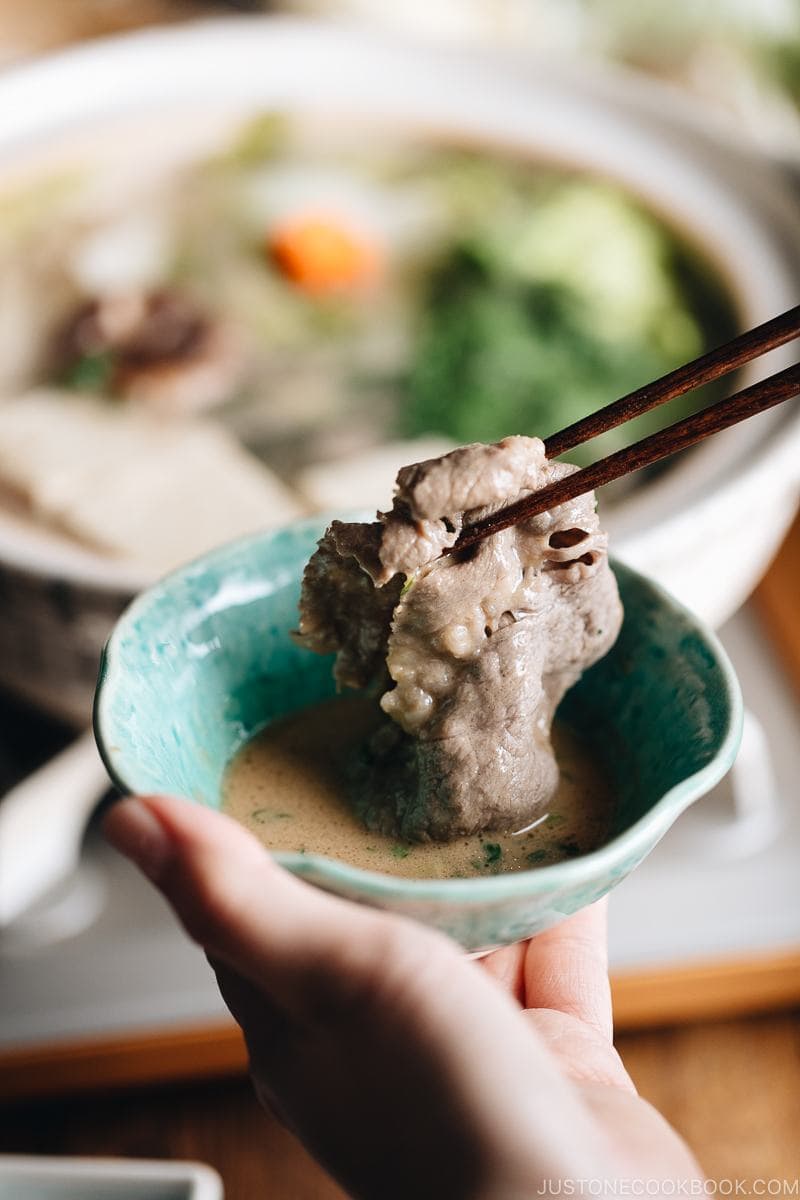
You continue to cook while you eat. There is a set of communal chopsticks to cook ingredients and serve. While cooking, make sure to skim scum and foam on the surface so you can have a more refined taste.
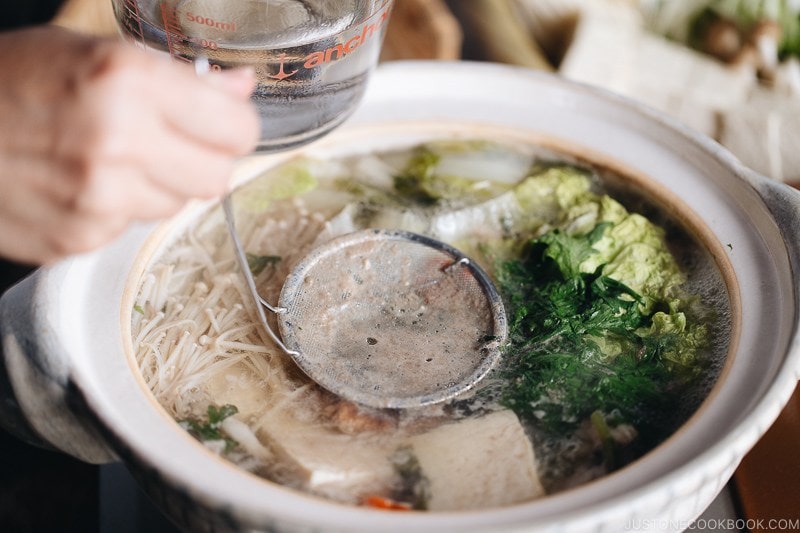
Once all the ingredients are cooked and taken away from the hot pot, you cook udon noodles in the remaining broth and enjoy.
If you dine at a shabu shabu restaurant, a restaurant staff will get you started by cooking a few ingredients first. Don’t hesitate to ask if you are unsure how to go about it. If you’re at home cooking up the hot pot, I hope this post will guide you through everything you need to know to enjoy your first Shabu Shabu experience.
The Key Shabu Shabu Ingredients and Substitute
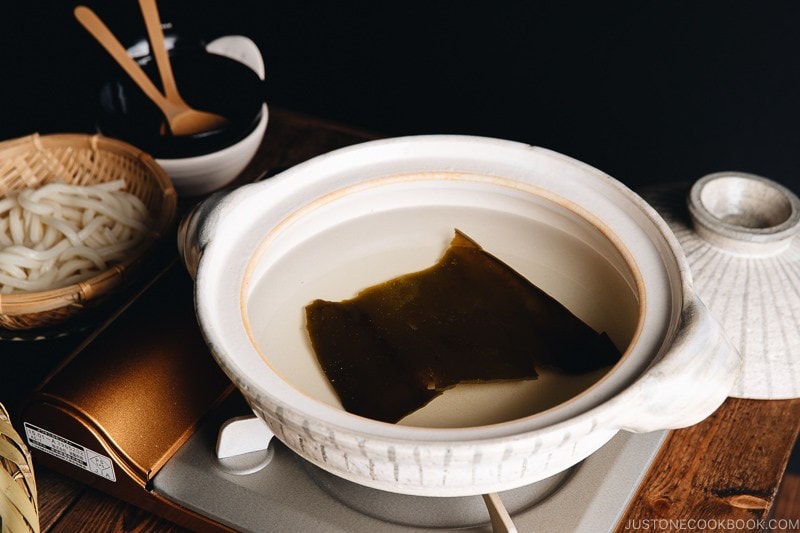
1. Kombu dashi
There are many different types of dashi (broth) but for shabu shabu we use dashi made from kombu (kelp). It is vegetarian and really easy to make. You can just drop a piece of kombu in a pot of water and let the flavor comes through. That’s it!!
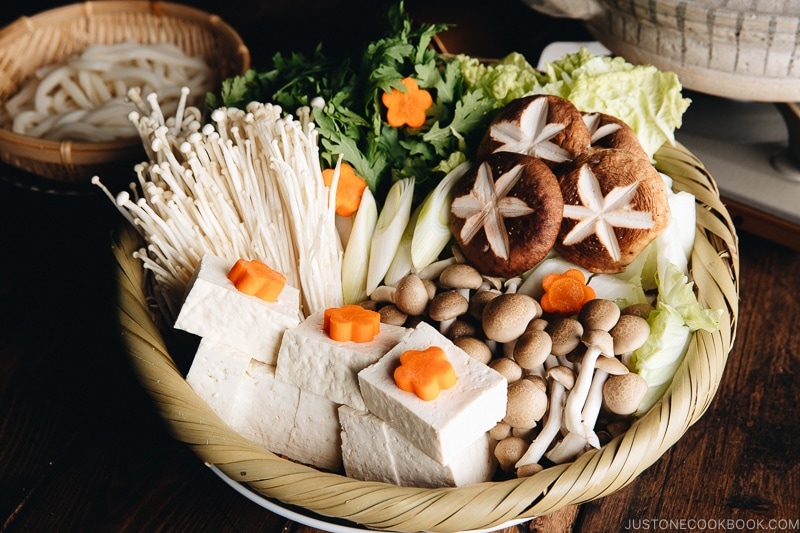
2. Vegetables + Mushrooms
The most commonly used vegetables for shabu shabu are: napa cabbage, shungiku (chrysanthemum greens or tong ho), long green onion (negi), and carrot. You can add other vegetables, like cabbage, broccoli, zucchini, and so on. But it’s worth making a trip to your nearest Asian grocery store for some harder-to-find ingredients like shungiku and long green onion. Chinese and Korean grocery stores usually carry the vegetables. For napa cabbage, you may have luck finding them at major grocery stores like Walmart, Target, Whole Foods etc.
Mushrooms that are often used in this recipe include shiitake mushrooms, enoki mushrooms, and shimeji mushrooms. You can use other types of mushrooms, such as button mushrooms, mostly to enjoy the different textures.
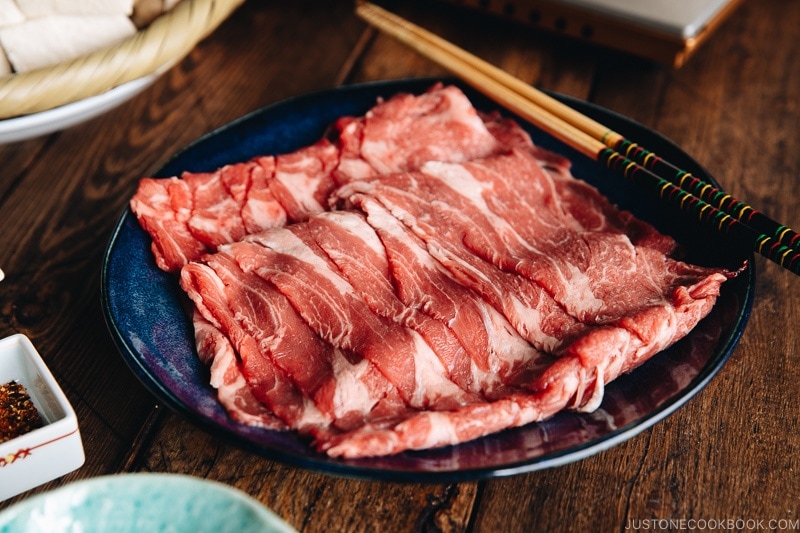
3. Thinly sliced meat: beef/pork
The most noticeable difference of having shabu shabu outside of Japan is the quality of meat. It can be difficult to source the same quality meat without paying a high price in the US. Supermarkets in Japan offer great quality beef at regular price. But we make it work!
Unless there is a well-stocked Japanese grocery store near you, you probably won’t be able to find thinly sliced meat in your local grocery store. So you have to thinly slice the meat yourself. It’s very easy to do, and here’s the tutorial.
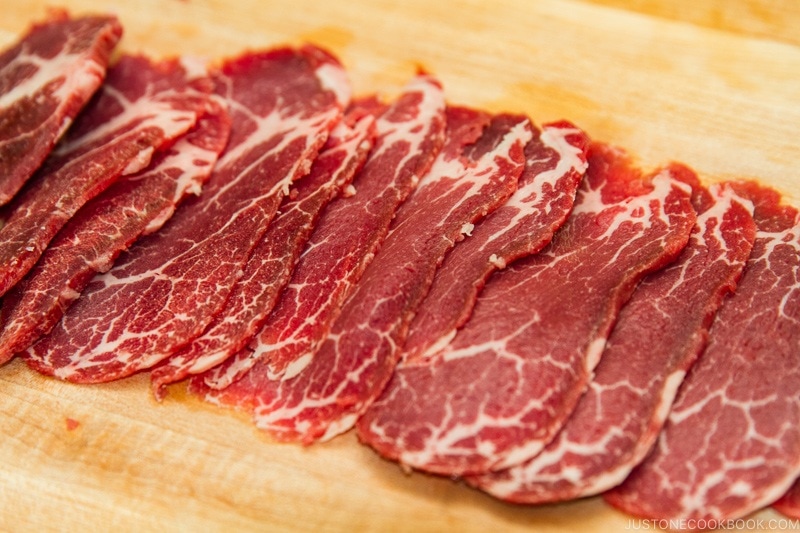
Prepare Shabu Shabu in Donabe
Shabu Shabu is cooked in kombu dashi in a donabe (土鍋), an earthenware pot, on a portal stove. If you don’t own one, you can use a Dutch oven or any large pot. Donabe and Dutch oven keep the contents warm for a long time, so it’s perfect for hot pot. If you own a donabe, this is a great chance to use it. But before you start, you need to season it. Here’s how you get it ready.
How To Season Donabe (Earthenware Pot)
Shabu Shabu – A Quick, Easy, and Healthy Meal All Year Around
As a busy mom, I not only make the hot pot during the holidays but all year around. I love that I don’t have to do the cooking before dinner time. All I need to do is to prepare the ingredients and some simple chopping, and let everyone cook dinner together at the table.
Since all the ingredients are cooked in broth, there is no oil used in the hot pot. It’s a very low-fat meal, and a great way to eat a lot of vegetables. Happy swishing and enjoy shabu shabu all year around!

Japanese Ingredient Substitution: If you want to look for substitutes for Japanese condiments and ingredients, click here.
Sign up for the free Just One Cookbook newsletter delivered to your inbox! And stay in touch with me on Facebook, Pinterest, YouTube, and Instagram for all the latest updates.
Shabu Shabu
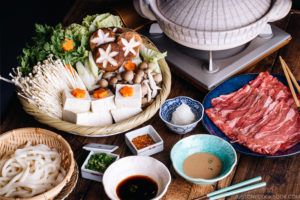
Shabu Shabu is a popular Japanese-style hot pot where the meat and assorted vegetables are cooked in a flavorful broth called kombu dashi. Everyone at the table takes part in the cooking and enjoys the ingredients with different dipping sauces. It’s intimate yet casual, and a whole lot of fun!
- 1 kombu (dried kelp) ((10 g, 3" x 3" or 7.5 cm x 7.5 cm))
- 1 package udon noodles ((9 oz/250 g) (I like Sanuki Udon))
- 8 leaves napa cabbage ((12 oz/340 g))
- ½ bunch shungiku (Tong Ho/Garland Chrysanthemum) ((4 oz/113 g))
- 1 Negi/Long Green Onion ((4 oz/113 g)(Use 2 green onions))
- 1 package enoki mushrooms ((7 oz/200 g))
- 1 package shimeji mushrooms ((3.5 oz/100 g))
- 4 shiitake mushrooms ((2.3 oz/65 g))
- 2 inches carrot ((2.3 oz/65 g))
- 1 package medium firm tofu ((14 oz/396 g) )
- 1 lb thinly sliced beef (chuck or rib eye) ((450 g)(Remember 4-5 oz/113-140 g per person))
To Serve
- 2 inches daikon radish ((5 oz/143 g))
- 2 green onions/scallions ((0.9 oz/25 g))
- Shichimi Togarashi (Japanese seven spice)
- Sesame Sauce ((See Notes for homemade recipe))
- Ponzu ((See Notes for homemade recipe))
-
Gather all the ingredients.
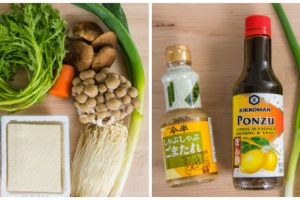
To Make Homemade Ponzu and Sesame Sauce
- If you are going to make homemade sauces, follow the recipes for Sesame Sauce and Ponzu Sauce. You can make the sauces ahead of time.
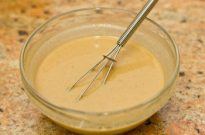
To Prepare Broth
-
Fill a donabe (Dutch oven or any large pot) two-thirds full with water. Add kombu and soak in water for at least 30 minutes. The right image shows the result after 30 minutes.
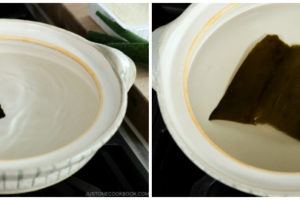
To Prepare Ingredients
-
Prepare udon noodles according to the instructions. Put frozen udon in a boiling water and reheat for 1 minute. Transfer to iced water to stop cooking with remaining, and drain well. Serve on a plate and set aside.
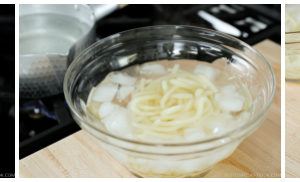
-
Cut napa cabbages into 2-inch (5 cm) pieces, and then cut each piece into half or thirds.
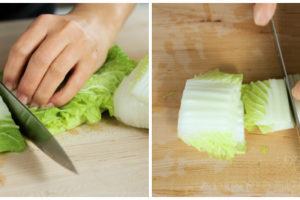
-
Cut the shungiku into 2-inch (5 cm) pieces.
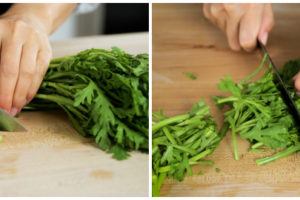
-
We only use the white part of negi (green onion/leeks). Cut it diagonally into ½ inch (1.3 cm) thick pieces.
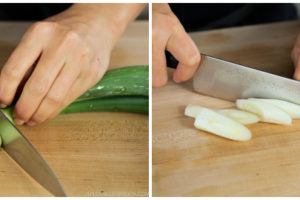
-
Rinse enoki and shimeji mushrooms. Discard the bottom of both mushrooms and separate into smaller chunks.
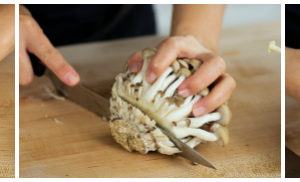
- Cut the stem of shiitake mushrooms. If you like, you can do a decorative cutting. See Cutting Technique.
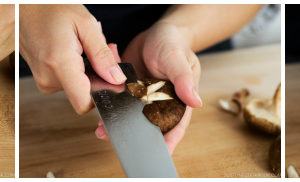
-
Cut the carrot into ¼ inch rounds. If you like, you can use a vegetable cutter to create a flower shape.

-
Cut the tofu into 1 inch (2.5 cm) thick square pieces.
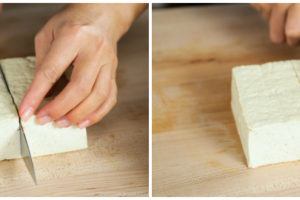
-
Arrange all the ingredients on a serving platter.
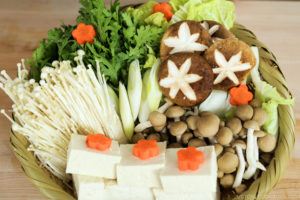
-
Peel daikon and grate using a grater. Squeeze grated daikon gently and put in a small bowl.
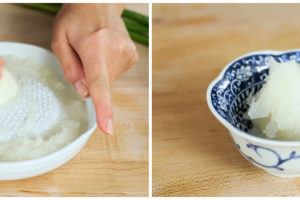
-
Cut the green onions into thin rounds and put it in a bowl.
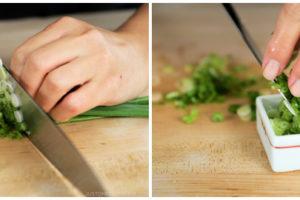
-
Prepare shichimi togarashi in a bowl (optional). Lay the thinly sliced beef on a plate.
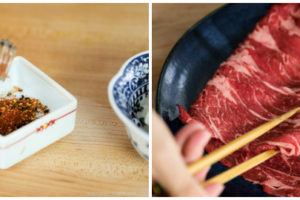
To Cook Shabu Shabu
-
Set a portable gas burner and put the donabe on the stove. Place platters with ingredients on the table. Give each person a ponzu sauce and sesame sauce. I also like to prepare an additional bowl for each person so they can use it to cool the food.
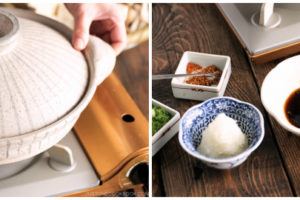
-
Bring the broth to a simmer over medium heat. Take out the kombu right before water starts to boil (otherwise, the water gets slimy).
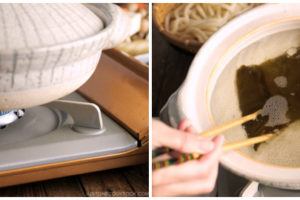
-
Add the tofu, the tough part of napa cabbage and shungiku, negi, carrots, and some mushrooms. You don’t have to put all the ingredients and cook in batches. Cover to cook for 10 minutes.
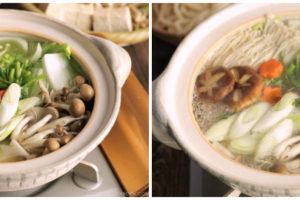
To Eat Shabu Shabu
-
While you’re waiting for the food to cook, prepare your dipping sauces. Add grated daikon, shichimi togarashi, and green onion in ponzu, and green onion in sesame sauce.
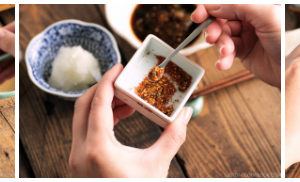
-
When you want to eat meat, pick up a slice of thinly sliced beef with a set of communal chopsticks and stir the meat in the boiling broth to cook for 10 seconds, or until the meat is no longer pink. Do not overcook the meat.
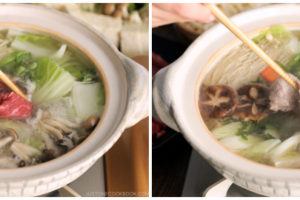
-
Take out the cooked beef and vegetables from the pot when they are done, and dip the food in ponzu or sesame sauce.
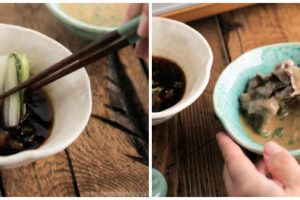
- Add remaining ingredients in the boiling broth as needed and simmer for a few minutes. Skim off the scum and fat from the broth as you repeat cooking. Prepare a fine mesh skimmer and a 2-cup measuring cup or bowl filled with water at the table so you can easily skim as you cook. Water in the measuring cup will help you get rid of scum from the skimmer.
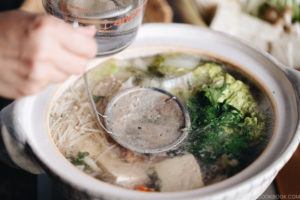
-
When all the ingredients are cooked, skim the broth for udon noodles. Typically, hot pot meal ends with cooking udon noodles or porridge.
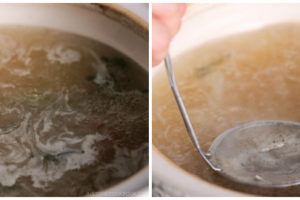
-
Add udon noodles in the pot and reheat for 1-2 minutes. Lightly season the udon soup with salt and white pepper, if you like (optional).
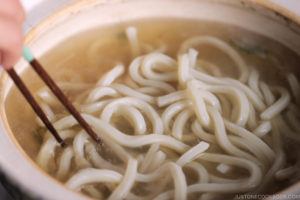
-
Dilute the ponzu sauce with the broth and serve udon noodles.
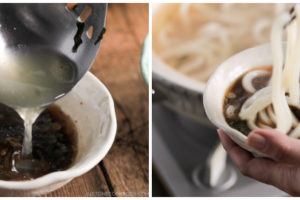
Sesame Sauce: You can purchase a bottle from Japanese grocery stores. To make my homemade Sesame Sauce recipe, click here.
Ponzu Sauce: You can purchase a bottle from Japanese grocery stores. To make my homemade Ponzu Sauce recipe, click here.
Japanese Ingredient Substitution: If you want to look for substitutes for Japanese condiments and ingredients, click here.
Recipe by Namiko Chen of Just One Cookbook. All images and content on this site are copyright protected. Please do not use my images without my permission. If you’d like to share this recipe on your site, please re-write the recipe in your own words and link to this post as the original source. Thank you.
Editor’s Note: This post was originally published on December 2, 2011. The post has been updated with a video and new images in December 2018.
